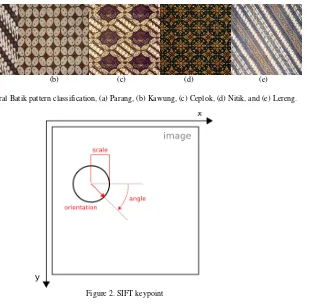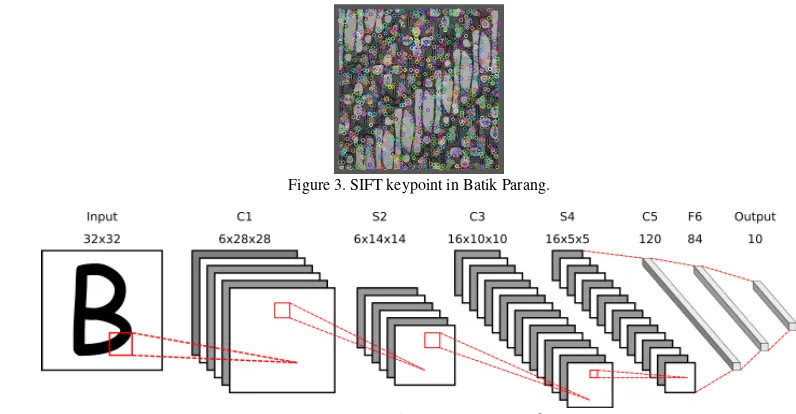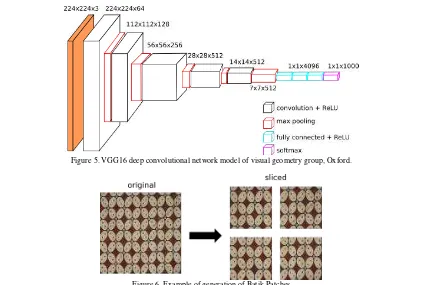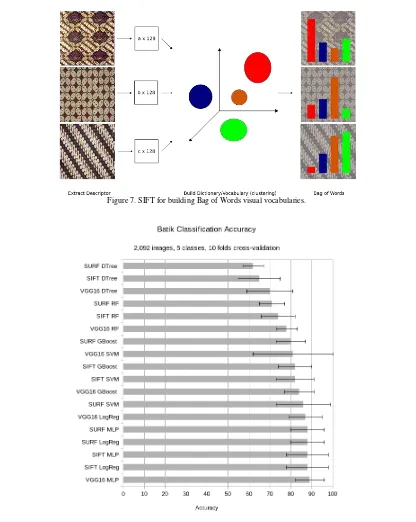59
Yohanes Gultom1, Rian Josua Masikome2, and Aniati Murni Arymurthy1
1Faculty of Computer Science, Universitas Indonesia, Kampus UI, Depok, 16424, Indonesia 2Faculty of Mathematics, Computer Science and Natural Sciences, RWTH Aachen University,
Templergraben 55, 52062 Aachen, Germany
E-mail: [email protected], [email protected], [email protected] Abstract
Batik fabric is one of the most profound cultural heritage in Indonesia. Hence, continuous research on understanding it is necessary to preserve it. Despite of being one of the most common research task,
Batik’s pattern automatic classification still requires some improvement especially in regards to invariance dilemma. Convolutional neural network (ConvNet) is one of deep learning architecture which able to learn data representation by combining local receptive inputs, weight sharing and convolutions in order to solve invariance dilemma in image classification. Using dataset of 2,092 Batik patches (5 classes), the experiments show that the proposed model, which used deep ConvNet VGG16 as feature extractor (transfer learning), achieves slightly better average of 89±7% accuracy than SIFT and SURF-based that achieve 88±10% and 88±8% respectively. Despite of that, SIFT reaches around 5% better accuracy in rotated and scaled dataset.
Keywords: batik, classification, deep learning, transfer learning
Abstrak
Kain Batik adalah salah satu warisan kebudayaan Indonesia yang sangat berharga. Oleh karena itu, penelitian yang berkesinambungan perlu dilakukan untuk melestarikannya. Sekalipun telah menjadi topik penelitian yang umum, klasifikasi pola Batik secara otomatis masih memiliki beberapa tantangan yang perlu diselesaikan. Salah satu tantangan tersebut adalah masalah invariance dilemma. Convolutional neural network (ConvNet) adalah salah satu arsitektur deep learning yang mampu mempelajari representasi data dengan mengkombinasikan teknik local receptive inputs, weight sharing dan convolutions untuk mengatasi masalah invariance dilemma pada klasifikasi citra seperti pola Batik. Eksperimen menggunakan dataset 2,092 potongan foto Batik (5 kelas) menunjukkan bahwa model yang menggunakan ConvNet VGG16 sebagai ekstraktor fitur mencapai rata-rata akurasi 89±7% sedangkan model berbasis SIFT dan SURF mencapai rata-rata 88±10% dan 88±8%. Meskipun demikian, SIFT lebih akurat sekitar 5% pada dataset yang dirotasi dan diperbesar.
Kata Kunci:batik, klasifikasi, deep learning, transfer learning
1. Introduction
Batik fabric is one of the most profound cultural heritage in Indonesia. Hence, continuous research on understanding it is necessary to preserve it. One of the most popular research topic in com-puter science is batik classification. This topic can not be separated from another crucial subtopic: feature extraction. It is because in order to achieve high classification accuracy, a machine learning model requires numerical features extracted from Batik images.
February 2018
Deep learning based models have outper-formed state-of-the-art methods in many domains including image classification and object recog-nition [7]. One of the deep learning models, con-volutional neural network (convnet) [8], is cur- rently considered as the state-of-the-art of image classification model as it was used as the base structure by ILSVRC-2014 top achievers [9]. Therefore convnet has potential to improve result on other image classification problems such as Batik classification.
In this paper, we propose a neural network Batik clas- sification model that uses pre-trained deep convolutional network (VGG16) [9] as a feature extractor. Features from a dataset of five general classes of Indonesian Batik (shown in Figure 1) are extracted using VGG16, SIFT and SURF then classified using several machine learning classifiers. In order to test the capability of the model to solve invariance dilemma, tests are also done with rotated and scaled (zoomed) images.
2.
MethodsRecent researches in Batik classification can be divided into two groups: (1) Researches on classi-fication using handcrafted features and (2) resear-ches on classification using automatically extract-ed features using deep learning.
Classification using Handcrafted Features
Since Batik classification has been researched for quite some time, current available methods are robust enough to noise addition, compression, and retouching of the input images. However most of them are still having difficulties with variance in transformations which involve either translation, rotation, scaling or combinations of them [4]. One of the initial work on Batik Classification was done using Generalized Hough Transform (GHT) to recognize Batik motifs as part of a content-based image retrieval (CBIR) [1]. The research focused on detection of repetitive motifs in a batik image but not yet addressed various orientations and scale.
One of the most recent research address the performance of several feature extraction methods (Gabor filter, log-Gabor filter, Gray Level Co-occurrence Matrix, and Local Binary Pattern) on rotated and scaled primitive Batik motifs [2]. It shows that applying Principal Component Analy-sis (PCA) to reduce dimensionality can improve the classification 17%. It also shows that applying Sequential Forward Floating Selection (SFFS) as feature selection makes the execution time 1,800 times faster.
Improvements on Batik classification were motivated by the emergence of Scale-Invariant (a) (b) (c) (d) (e)
Figure 1. General Batik pattern classification, (a) Parang, (b) Kawung, (c) Ceplok, (d) Nitik, and (e) Lereng.
Feature Transform (SIFT) [10] and Speeded up robust features (SURF) [11]. Both of these key-point-based feature extraction methods are pro- posed to solve the transformation invariance dile-mma. SIFT keypoint is a circular image region with an orientation which can be obtained by detecting extrema of Difference of Gaussian
(DoG) pyramid [10]. It’s defined by four param- eters: center coordinates x and y, scale and its orientation (an angle expressed in radians) as shown in Figure 2. An image, for example Batik image, may contains multiple keypoints as shown in Figure 2. In order to be efficiently and effecti-vely used as a feature for classification, the keypoint need to be represented as SIFT descrip-tor. By definition it is a 3-dimensional spatial his-togram of the image gradients characterizing a SIFT keypoint.
Recent research proved that using SIFT descriptors to calculate similarity between Batik images can give 91.53% accuracy [4]. Voting Hough Transform was also applied to the desc-riptors to eliminate mismatched keypoint candi- dates hence improving the accuracy. This research suggested that the original SIFT descriptor match-ing should not be directly used to calculate simi-larity of Batik images due to many numbers of mismatched keypoints. This research uses funda-mental templates of Batik patterns as a dataset instead of Batik photos. So it does not address issue related to noises which happen on non-processed images such as blur/unfocused, light-ning issue, watermarks .etc.
Another research [3] proposed a classifica-tion method using support vector machine (SVM) fed by bag of words (BoW) features extracted using SIFT descriptors. In this research, SIFT des-criptors also were not used directly as features for
SVM but were clustered using k-means vector quantization algorithm to build vocabularies. The-se visual vocabularies then uThe-sed to describe each images and fed to SVM classifier. This approach is required because SIFT descriptors have high dimensionality and vary between each images. The experiment results showed high average ac- curacy of 97.67% for normal images, 95.47% for rotated images and 79% for scaled images. Besides that SIFT and bag of words made a good feature extractor, this research also concluded that further works need to handle scaled Batik image cases.
An earlier research [5] proved that SURF can extract transformation invariant features faster than SIFT for classification of Songket, another Indonesian traditional fabric with motifs just like Batik. Unlike the others, this research used SIFT and SURF features directly to compute the match-ing scores between Songket images. The scores are calculated by (1) the number of matched keypoints and (2) the average total distance of the n-nearest keypoints. The result of experiments showed that the matching accuracy with SIFT features was 92-100% and 65-97% with SURF. With SURF features, the accuracy dropped quite significant if salt and pepper noises were added while SIFT was more stable. Apparently, this one was not paying much attention to transformation variance as it did not apply transformation noise as in other research [3].
Classification using Deep Learning
Deep learning is a multilayer representation learn-ing in artificial neural network [7]. While repre-sentation learning itself is a method in machine learning to automatically extract/learn representa-Figure 3. SIFT keypoint in Batik Parang.
February 2018
tion (features) from raw data. The representation of the raw data then can be used for recognition or classification task. Some fundamental deep learn-ing architectures for instances are convolutional neural network (ConvNet), deep belief network (DBN), autoencoder (AE) and recurrent neural network (RNN). Despite of being an old idea, it was recently emerged due to the several factors: (1) discovery of new techniques (eg. pretraining & dropout) and new activation functions (eg. ReLU), (2) enormous supply of data (big data), and (3) rapid improvement in computational hard-ware, especially GPU.
Proposed Method
We propose a deep convolutional neural network com- posed by a pre-trained VGG16 (without its top layer) as automatic feature extractor and a multi-layer perceptron (MLP) as classifier. The method of using pre-trained deep network as part of another neural network to solve different (but related) task can be considered as transfer learning or self-taught learning [14].
Convolutional Neural Network
Convolutional network is a special kind of neural net- work optimized to learn representation of an image [7]. It introduces 2 new types of hidden layers: convolutional and subsampling/pooling layers. Each layer in convnet connects neurons
(pixels) from their input layer in form of local receptives (square patches) through a shared weights to a feature map [8]. On top of a set of convolutional and pooling layers, some fully-connected layers are added as classifier as described by Figure 4.
yi= log(1 + exp xi) (1)
yi = 𝑒 𝑥𝑖
∑𝐾 𝑒𝑥𝑘 𝑘=1
for i=1..K
(2)
rjx∼ Bernoulli(p)
ỹi = r ∗i y i
(3)
VGG16 is a very deep convnet model made by Visual Geometry Group (VGG), University of Oxford [9]. It was trained on 1,000,000 images dataset from ImageNet and achieve state-of-the-art results on Large-Scale Visual Recognition Challenge (ILSVRC) 2014. It contains 16 hid- den layers composed of convolutional layers, max pooling layers and fully-connected layers as shown in Figure 5. The convolution and fully-connected layers uses ReLu activation function (Equation 1), except the output layer that uses a SoftMax activation function (Equation 2) to estimate probability of multiple classes/labels. Dropout is also used as regularization after each tanh fully-connected layers to avoid overfitting by randomly drop/turn off (set value to zero) hidden Figure 5. VGG16 deep convolutional network model of visual geometry group, Oxford.
nodes (Equation 3) [15]. works model learns data representation using small training data. One of the technique is trans-ferring knowledge of another pre-trained neural network model to our model. This technique is known as transfer learning or self- taught learning [14].
Our proposed model uses transferred know-ledge (layer weights) from pre-trained VGG16 model (provided by deep learning framework Keras1) which was pre-trained using 1,000,000 images dataset from ImageNet. Intermediate out- puts of VGG16 can be used to extract generic features for any image classifier [13]. Therefore, even though VGG16 was not designed to classify Batik patterns, it should be able to extract useful generic features from Batik images which can be used further for classification.
Compared to SIFT/SURF BoW, using pre-trained VGG16 allows us to reduce time needed to extract features because no training required for the feature extractor. Moreover, since our propo-sed model is bapropo-sed on neural network, execution time may also be reduced significantly by utili-zing GPU parallelization.
To improve comprehension and reproduce-bility, the proposed model and experiment codes are also available in public online code reposi-tory2. This research also utilizes opensource TensorFlow-backed Keras as deep learning frame- work and scikit-learn3 library for classification and evaluation to reduce amount of codes written so they can be easily studied further.
Experiments
To measure the performance of our model, we trained our model and compared it with SIFT and SURF based models.
The dataset used in the experiments original-ly comes from Machine Learning and Computer Vision (MLCV) Lab, Faculty of Computer Scien-ce, University of Indonesia. The original dataset consists of 603 Batik photos (± 78.3 MB) gather-ed from various sources thus having different size, quality and view angle. But based on the previous research, this dataset is expanded by equally slicing each image to four patches (Figure 6) for better accuracy [12]. Hence, the dataset used in the experiments contains 2,092 images (patches) of five classes: Ceplok (504 images), Kawung Logistic Regression, Support Vector Machine (RBF Kernel), Multi-Layer Perceptron (1 ReLU hidden layer, 100 nodes), Decision Tree, Gradient Boosting and Random Forest. The dataset is minimally preprocessed by converting each image to grayscale before processed by three extractors: (1) SIFT BoW extracts 2800 features, (2) SURF BoW extracts 2800 features, and (3) VGG16 extracts 512 features.
While, VGG16 extractor does not require any training because pre-trained model (weights) are used, the SIFT and SURF features extractors are trained using the best methods (achieving highest accuracy) described in previous research [3] (illustrated in Figure 7): (1) Image descriptors were extracted according to their feature extractor VGG16
MLP
88.30 96.28 90.96 91.84
TABEL 2
MODELS ACCURACY COMPARISON ON SCALED TEST DATA
Model Accuracy on Zoom-In Average
February 2018
(SIFT or SURF), (2) Descriptors were clustered to 2800 clusters using K-Means to get visual vocabularies for BoW, and (3) Those 2800 visual vocalbularies then used to compute BoW features from SIFT/SURF image descriptors to produce 2800 features.
In the first experiment, each extracted feature is used to trains and tests six different classifiers mentioned above using 10 folds cross validation. So effectively, each classifier is trained
using 1,883 images and tested using 209 images 10 times. The results are averaged and then compared to see which combination of extractor and classifier performs the best.
The best combinations of each three extractors from first experiment are tested for their capa-bility to handle invariance dilemma in the second experiment. There are three steps of experiments. First step is each combinations of the best extractors-classifiers are trained using 2,092 Figure 7. SIFT for building Bag of Words visual vocabularies.
The last step is each combinations of the extractors-classifiers are tested against those six transformed test datasets.
All experiments were conducted using Intel Core i7 5960X CPU, 66 GB RAM, NVIDIA GTX 980 4GB GPU, 240GB SSD, Debian 8 OS. The VGG16 extractor runs on GPU to reduce the execution time but the result should not be different than running it on CPU.
3. Results and Analysis
In the first experiment, the proposed model (VGG16 MLP), achieved slightly better (1%) accuracy and less deviation than the best SIFT and SURF models (SIFT LogReg and SURF MLP) as shown by chart in Figure 8. The average accuracy achieved by the proposed model is also ±8% better than Stacked-Autoencoder [12] that used dataset from same origin.
On general, the result also shows that VGG16 extractor performs as well as SIFT and SURF extractors despite of fewer features dimen-sion (512 features against 2,800 features). Since VGG16 extractor does not require training, it is more efficient than SIFT/SURF BoW extractor. On top of that, neural network models such as VGG16 are known to run parallelly in GPU [16] to make it event more efficient.
It is also shown that decision-tree-based classifiers (Decision Tree, Random Forest and Gradient Boosting) generally achieve lower accu-racy compared to non decision tree classifiers. Only SIFT Gradient Boosting and VGG Gradient Boosting which outperform SVM classifiers. This shows that the extracted features do not have nominal scale which is usually suitable with deci-sion tree-based classifiers. Meanwhile, SVM, which represents non-linear classifier, is outper-formed by logistic regression and single layer ReLU MLP that represent linear classifier. This result shows that the features extracted by SIFT, SURF and VGG16 are not linearly separable.
In the second experiment, the proposed model (VGG16 MLP) shows slightly less accurate results compared to SIFT and SURF models. For rotated and zoomed-in datasets, SIFT model is ±5% better than VGG16 model. While SURF model is ±5% better than VGG16 only on rotated datasets but ±3% worse than it. Despite of that, the accuracies of the proposed model are
general-4. Conclusion
Based on the experiment results and analysis, there are several points can be concluded: Pre-trained VGG16 extractor with MLP classi- fier slightly outperformed SIFT and SURF based models in term of accuracy for non-trans-formed dataset. Despite of not performing as good as SIFT and SURF models on transformed data-sets, it still achieves relatively high accuracy. This confirms that automatic feature extraction using pre-trained convolutional are able to handle trans-formation invariant features such as Batik motifs as good as SIFT and SURF as also concluded by related research [13].
Pre-trained VGG16 extractor is more effici-ent than SIFT and SURF bag of words (BoW) because it does not require any form of data fitting or training with Batik dataset. Meanwhile, SIFT/ SURF requires clustering of Batik SIFT/SURF descriptors in order to build visual vocabularies. On top of that, VGG16 extractor can be run paral-lely on GPU to further reduce execution time.
Features extracted by VGG16, SIFT and SURF do not scale like nominal data and are linearly separable. Hence, decision-tree-based (ID3, Gradient Boosting and Random Forest) and non-linear classifiers perform less accurate com-pared to linear classifiers (Logistic Regression and single hidden layer MLP).
There are also some aspects that can be explored to improve the research further: VGG16 is not the only pre-trained deep learning model available. So further research needs to compare performance of other pre-trained models such as VGG19 [9], Xception [17], ResNet50 [18] .etc on Batik datasets.
As majority of the data are mixed-motif Batik, each images should be classified to multi-ple classes at the same time (eg. Parang and Kawung). So current dataset should be relabeled to show the multi-label information of each Batik images.
Certain images in dataset often overlap each other (eg. Parang and Lereng motifs). This con- dition often confuses classifier during training and causes less accurate generalization. Therefore better (stricter) data labeling may further increase the accuracy of classification models.
February 2018
data are also various. Removing low quality data and preprocessing high quality ones may produce homogeneous data and improve classifier accu-racy
References
[1] H. R. Sanabila and R. Manurung,
“Recognition of batik motifs using the generalized hough transform,” University of
Indonesia, 2009.
[2] H. Fahmi, R. A. Zen, H. R. Sanabila, I. Nurhaida, and A. M. Ary- murthy, “Feature selection and reduction for batik image
retrieval,” in Proceedings of the Fifth
International Conference on Network, Communication and Computing. ACM, 2016, pp. 47–52.
[3] R. Azhar, D. Tuwohingide, D. Kamudi, N.
Suciati et al., “Batik image classification
using sift feature extraction, bag of features
and support vector machine,” Procedia
Computer Science, vol. 72, pp. 24–30, 2015. [4] I. Nurhaida, A. Noviyanto, R. Manurung, and
A. M. Arymurthy, “Au- tomatic indonesian’s
batik pattern recognition using sift approach,”
Procedia Computer Science, vol. 59, pp. 567– 576, 2015.
[5] D. Willy, A. Noviyanto, and A. M.
Arymurthy, “Evaluation of sift and surf
features in the songket recognition,” in
Advanced Computer Science and Information Systems (ICACSIS), 2013 International Con- ference on. IEEE, 2013, pp. 393–396. [6] V. S. Moertini and B. Sitohang, “Algorithms
of clustering and clas- sifying batik images
based on color, contrast and motif,” Journal
of Engineering and Technological Sciences, vol. 37, no. 2, pp. 141–160, 2005.
[7] Y. LeCun, Y. Bengio, and G. Hinton, “Deep
learning,” Nature, vol. 521, no. 7553, pp. 436–444, 2015.
[8] Y. LeCun, L. Bottou, Y. Bengio, and P.
Haffner, “Gradient-based learning applied to
document recognition,” Proceedings of the
IEEE, vol. 86, no. 11, pp. 2278–2324, 1998. [9] K. Simonyan and A. Zisserman, “Very deep
convolutional networks for large-scale image recognition,” arXiv preprint arXiv:1409.1556, 2014.
[10]D. G. Lowe, “Distinctive image features from scale-invariant key- points,” International journal of computer vision, vol. 60, no. 2, pp. 91–110, 2004.
[11]H. Bay, T. Tuytelaars, and L. Van Gool,
“Surf: Speeded up robust features,” in
European conference on computer vision. Springer, 2006, pp. 404–417.
[12]R. A. Menzata, “Sistem perolehan citra berbasis konten dan klasifikasi citra batik
dengan convolutional stacked autoencoder,”
Universitas Indonesia, 2014.
[13]P. Fischer, A. Dosovitskiy, and T. Brox,
“Descriptor matching with convolutional neural networks: a comparison to sift,” arXiv
preprint arXiv:1405.5769, 2014.
[14] R. Raina, A. Battle, H. Lee, B. Packer, and
A. Y. Ng, “Self-taught learning: transfer learning from unlabeled data,” in Proceedings of the 24th international conference on Machine learning. ACM, 2007, pp. 759–766. [15]N. Srivastava, G. E. Hinton, A. Krizhevsky, I.
Sutskever, and R. Salakhutdinov, “Dropout: a simple way to prevent neural networks from
convolutional neural networks,” in Advances
in neural information processing systems, 2012, pp. 1097–1105.
[17]F. Chollet, “Xception: Deep learning with depthwise separable con- volutions,” arXiv preprint, 2016.
[18]K. He, X. Zhang, S. Ren, and J. Sun, “Deep
residual learning for image recognition,” in



